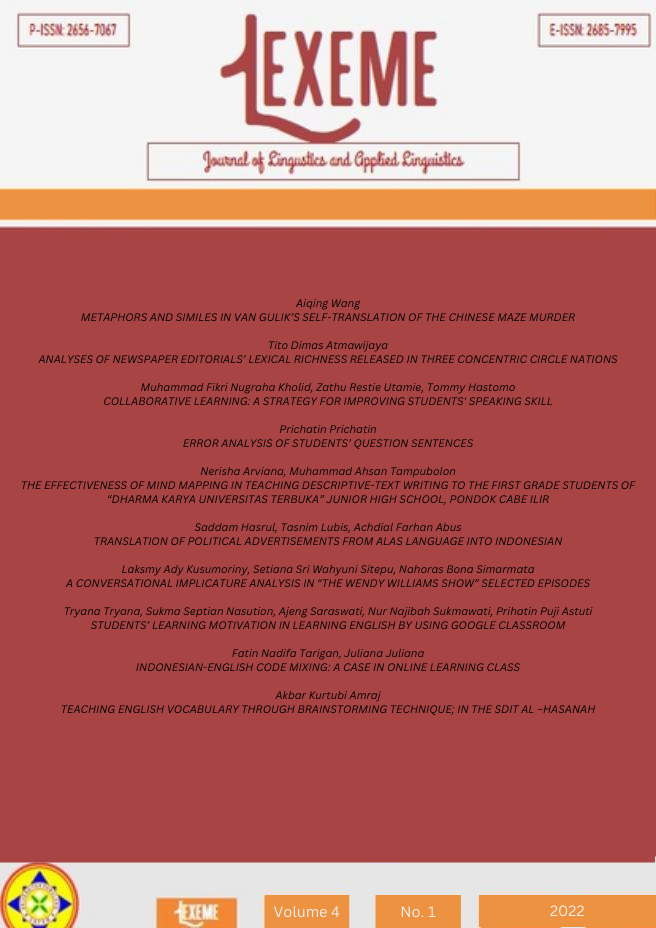ERROR ANALYSIS OF STUDENTS’ QUESTION SENTENCES
DOI:
https://doi.org/10.32493/ljlal.v4i1.19065Keywords:
grammatical errors, question sentencesAbstract
Indonesia and English have different grammatical rules. That is why some students make mistake in writing or speaking English sentences. For example, in Indonesia Language, the question sentence does not use auxiliary, while in English, we need different auxiliaries in making question sentence. The aim of this research is to know the errors which have been made by the second semester students at English Department in Pamulang University in question sentences, to identify the error made by the students, and to correct the errors. The research uses theory of grammatical errors taxonomy by Ho (2005). According to Ho, there are four types of Grammatical errors; are noun and noun group errors, verb and verb group errors, prepositional errors, and sentence structure errors. Qualitative method is used to obtain valid finding. Twenty five (25) question sentences were collected from 41 students in the second semester Faculty of Letters Pamulang University. Based on the error analysis conducted, it is found that the most dominant errors is errors regarding to verb-verb group (11 case or 44%), with the omission of auxiliary verb is the highest number of errors done by students (36%). This is followed by the errors regarding to sentence structure (28%). In the third position, there are errors regarding noun-noun group (12%) and capitalization errors (12%), which is not categorized in the (Ho, 2005) theory. Last the error regarding to the preposition is in percentage 4%. The finding indicates that some students find difficulties in using auxiliary verbs in their question sentence. This problem may occur because Indonesian does not use auxiliary verb in the question sentences.
References
Azar, B. S. (2011). Fundamentals English Grammar. (fourth ed.) Pearson Education
Arikunto, S. (2002). Prosedur Penelitian: Suatu Pendekatan Praktik. Jakarta: Bina Aksara.
Brown, H. D. (2000). Principles of Language Learning and Teaching, New York: Pearson Education, Inc.
Corder, S.P. (1974) . “Error Analysisâ€. In J. Allen and S. P. Corder (eds.), The Edinburgh Course in Applied Linguistic. Oxford: Oxford University Press.
Erdogan, V. (2005). Contribution of Error Analysis to Foreign Langauge Teaching. Mersin Univeristy Faculty of Education.
Greenbaum, S & Nelson, G. (2002). An Introduction to English Grammar (Second ed.). Essex: Longman
Ho, C. (2005). Empowering English Teachers to Grapple with Errors in Grammar. Singapore: Nanyang University Press.
https://www.merriam-webster.com/dictionary/grammar accessed on 03 dec 2020 08.46 PM
Patterson, N.G. (1999). The role of grammar in the language arts curriculum. Retrieved July 19, 2013, from http://www.npatterson.net/grammar.html
Richards, C. J. (1973). Error Analysis Perspective on Second Language Acquisition. Longman.
Seaton, A. & Mew, Y.H. (2007) Basic English Grammar for English Language Learners. USA: Saddleback Educational Publishing







